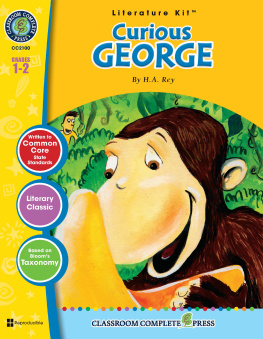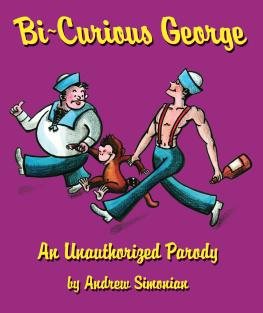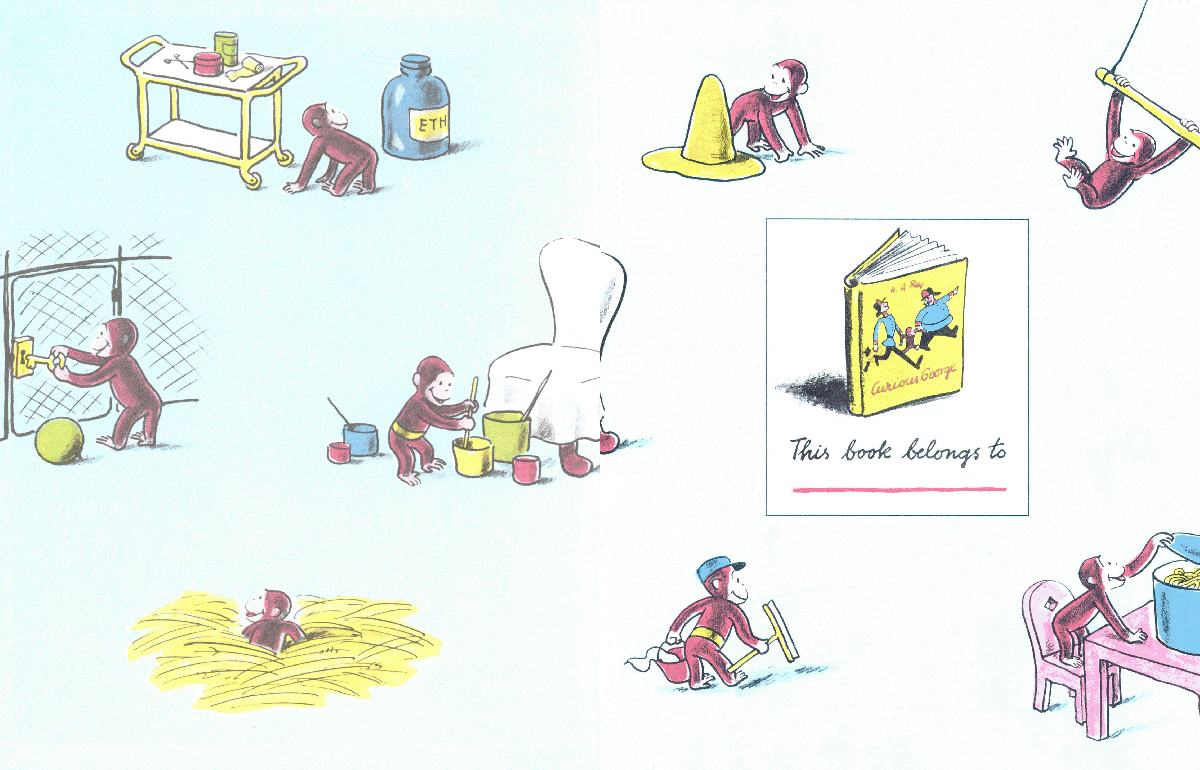
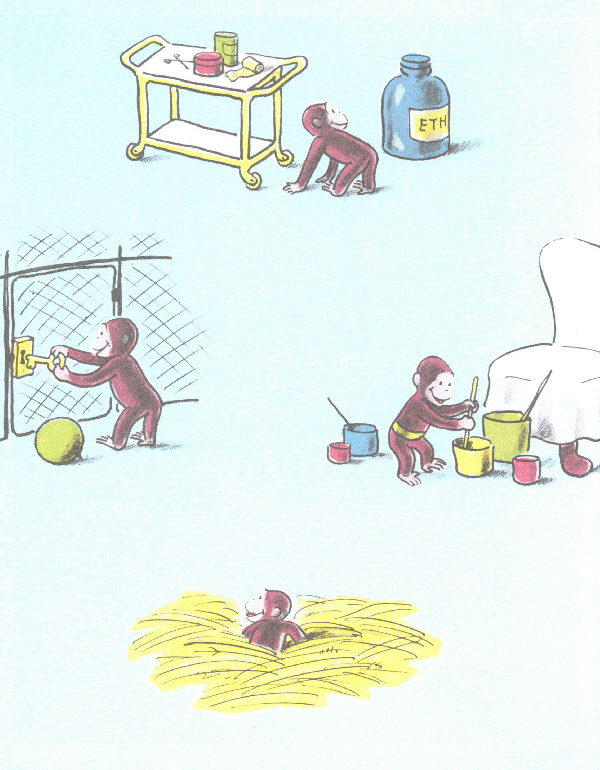
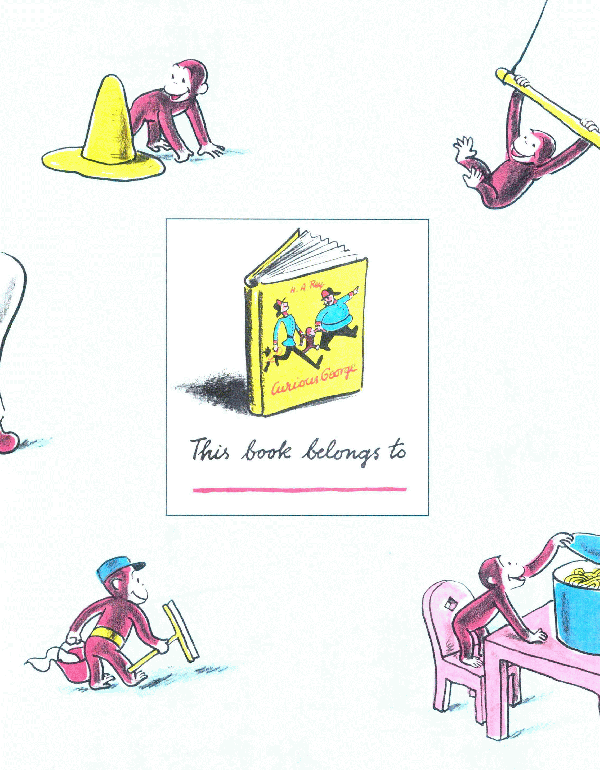
This book belongs to
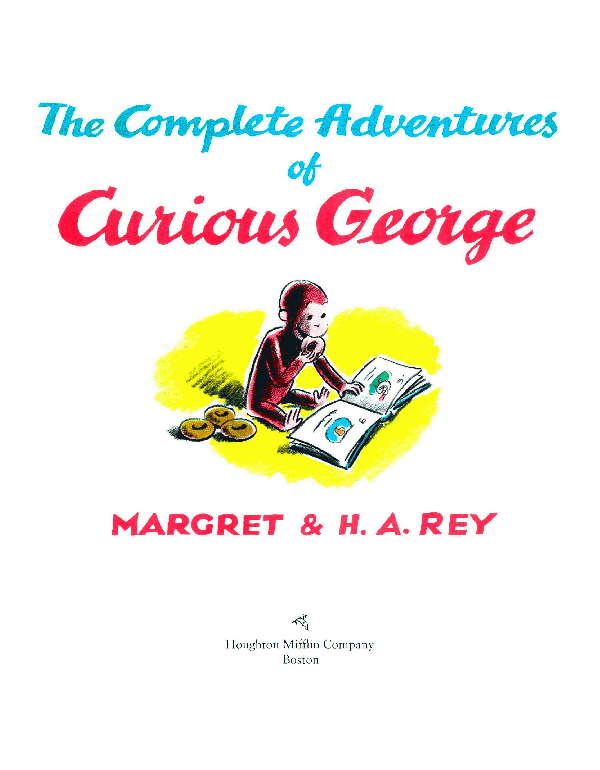
The Complete Adventures
of
Curious George
MARGRET & H. A. REY
Houghton Mifflin Company
Boston
All rights reserved. For information about permission to reproduce selections from this book, write to
Permissions, Houghton Mifflin Company, 215 Park Avenue South, New York, New York 10003.
Introduction copyright 2001 by Leonard S. Marcus
Publisher's Note copyright 2001 by Houghton Mifflin Company
Curious George
Copyright 1941 and renewed 1969 by Margret E. Rey
Copyright assigned to Houghton Mifflin Company in 1993
Curious George Takes a Job
Copyright 1947 and renewed 1975 by Margret E. Rey
Copyright assigned to Houghton Mifflin Company in 1993
Curious George Rides a Bike
Copyright 1952 by H. A. Rey
Copyright renewed 1980 by Margret E. Rey
Copyright assigned to Houghton Mifflin Company in 1993
Curious George Gets a Medal
Copyright 1957 and renewed 1985 by Margret E. Rey
Copyright assigned to Houghton Mifflin Company in 1993
Curious George Flies a Kite
Copyright 1958 by Margret E. Rey and H. A. Rey
Copyright renewed 1986 by Margret E. Rey
Copyright assigned to Houghton Mifflin Company in 1993
Curious George Learns the Alphabet
Copyright 1963 by H. A. Rey
Copyright renewed 1991 by Margret E. Rey
Copyright assigned to Houghton Mifflin Company in 1993
Curious George Goes to the Hospital
Copyright 1966 by Margret E. Rey and H. A. Rey
Copyright renewed 1994 by Margret E. Rey
Copyright assigned to Houghton Mifflin Company in 1993
Retrospective Essay copyright 2001 by Dee Jones
Photographic Album copyright 2001 the de Grummond Children's Literature Collection,
The University of Southern Mississippi, Hattiesburg
Manufactured in the United States of America
DOW 10 9
Contents
Introduction by Leonard S. Marcus
Curious George: A Publisher's Perspective
Curious George 3
Curious George Takes a Job 57
Curious George Rides a Bike 105
Curious George Gets a Medal 153
Curious George Flies a Kite 201
Curious George Learns the Alphabet 281
Curious George Goes to the Hospital 353
Retrospective Essay 401
Photographic Album of Margret and H. A. Rey 415

An illustration from the original Curious George
Introduction
Curious George, quintessential childhood tale of monkeyshines and mischief, was the creation of wartime refugees who knew, better than George himself, what it meant to escape by the seat of one's pants. A self-taught artist, Hans Augusto Rey (18981977) and his Bauhaus-trained wife and collaborator, Margret (19061996), were German Jews who met and married in Brazil in 1935. After cofounding the first advertising agency in Rio de Janeiro, they returned to Europe in 1936, remaining in Paris until just hours before the German army entered the French capital on June 14, 1940. Then, fleeing by bicycle with their winter coats and several picture books strapped to the racks (including the watercolors and a draft of the as-yet-unpublished Curious Georgethen called Fifi), they crossed the French-Spanish border, caught a train bound for Lisbon, and then sailed to Brazil. Hans's Brazilian passport and Roosevelt's Good Neighbor Policy eased the couple's passage to the United States.
As a university student in Germany, Hans Rey had read philosophy and natural sciences and mastered several languages. It was largely by chance that this restless polymath, who also had a knack for drawing, embarked on a career in children's books. When an editor at the French house Gallimard admired his animal illustrations for a Paris newspaper, Rey, who was then in his thirties, responded by submitting the picture book later published in the United States as Cecily G. and the 9 Monkeys (Houghton Mifflin, 1942). The French Cecily marked not only Rey's debut in the field but also the first appearance of Curious George (who, under the name "Fifi," figures in the story as one of the nine). As more books for Gallimard followed, Rey also established a foothold in Britain, where Grace Hogarth, an American employed in London as Chatto & Windus's children's book editor, took an interest in his work. When wartime considerations prompted both Hogarth and the Reys to plan on resettling in the States, the editor secured from Hans the promise of a first look at whatever projects he might bring over with him.
Soon after the couple's arrival in New York, in October 1940, Hogarth, who had assumed the editorship of Houghton Mifflin's newly formed children's books department, came down from Boston to inspect the artist's wares. At canny Margret's insistence, Hogarth agreed to a then rare four-book contract. It was thus that in the fall of 1941 Houghton Mifflin published Curious George (the new title was the publisher's happy idea) as well as a novelty book called How Do You Get There? Cecily G. and the 9 Monkeys and a second lift-the-flap book, Anybody at Home?, followed a year later. (In 1942, Chatto & Windus issued the first British edition of Curious George under yet another title, Zozo: George was the reigning monarch's name, and in 1940s Britain, curious meant "gay.")
Margret, who was a famously tenacious negotiator, continued to mind the couple's business affairs while writing books of her own and contributing substantially to her husband's creative efforts as ad hoc art director and sometime coauthor. On occasion she even posed for drawings of George. In social situations, Hans typically made the gentler impression: when he roared like a lion, it was most often to make visiting children laugh. Nonetheless, Rey the artist was a steely perfectionist. In Paris, he had worked closely with the skilled artisans responsible for the printing of his books. To accommodate his wish to do so again, Hogarth chose a suitable New York printer, William Glaser, specialist in fine color work.
Rey may have assumed at first that his original watercolors were destined for reproduction by the same exactingand costlyphotolithographic process favored in Europe. Thrifty American publishers, however, reserved photolithography for picture books assured of a substantial sale, and Rey had arrived in the United States an unknown. Moreover, the manager of the trade department and Hogarth's superior, Lovell Thompson, had concluded that the watercolors for Curious George looked "as if the author still planned to point them up ... and clean them up [in places]." Thompson ruled that a new set of "pre-separated" illustrations based on the watercolors should instead be prepared.
Whatever Rey's own first thoughts on the subject may have been, he quickly adapted to circumstance, as well as to the more graphic, less painterly aesthetic implicit in the method of reproduction made available to him. In preparing the separations for
Next page

